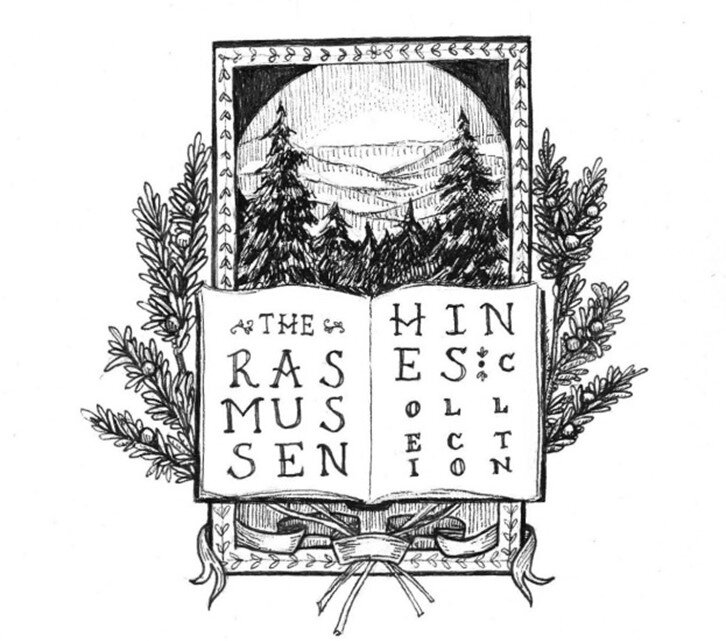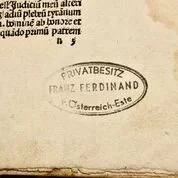[ARCHDUKE FRANZ FERDINAND, association] Gesta Rhomano(rum): Cu(m) Applicationibus Moralisatis ac Misticis. Full title page transcription: Ex gestis Romanoru[m] cum plurib[us] applicatis historijs de virtutib[us] et vicijs mystice ad intellectu[m] tra[n]ssu[m]ptis recollectorij finis. Anno n[ost]re salut[is] Mcccclxxxviij. Kalendas vero Februarij. xviij. [Strasbourg, Johann Grüninger, 18 February 1488.][1]
2o. Text is comprised of Gothic letters set in two columns of fifty lines each. A reprint of a c. 1485 Strasbourg edition by Martin Schott. Contains continuous rubrication by hand with Lombard initials and paragraph marks in red, blue, and green, many of the initials with fleunonée.
Early inscriptions or little drawings with ink on leaves a3r, a4r, a7r, e1r, h5r, i4v, k1v, k5r, k8r, k8v (6 lines of a German language poem), l4v, n1v, n2r, n7r. Fore margin of leaf o2 with fault (no text loss), lower right margins of leaves a2, a3, a4 and l2, as well as o6v torn and repaired, wormholes starting from leaves a2-h8 (at a2-b4 and e4-f3 stronger, with decreasing occurrence, otherwise very little, with repair of leaf a2), fore margins of a4-a6, a8-b8, m2-o6 with stronger water stains of different intensity, a number of leaves slightly finger-stained, foxy and with traces of dirt or colour. ISTC ig00291000; Goff G291; GW 10896; et. al.
Gesta Romanorum is an anonymous collection of moral tales and anecdotes, likely compiled in the late 13th/early 14th century. It was immensely popular in its own time and later served as a source for Chaucer, Boccaccio, and Shakespeare, among others. The earliest known printed copies likely date to the mid 1470s (Utrecht and Cologne). The ISTC lists fifty-six copies of this edition, printed by Johann Grüninger in Strasbourg in 1488, in institutions worldwide. Only one other copy is available west of the Mississippi, at the Huntington Library. The RH Collection’s copy’s extensive rubrication makes it even more unusual.
Regarding its provenance, while “Archduke Franz Ferdinand” is a name that will likely ring a bell for many, the manner and consequences of Franz Ferdinand’s death—an assassination in Sarajevo that triggered the First World War—have overshadowed the details of his life. He is largely remembered as a fanatical hunter, determined to kill as many animals as possible during his world travels, and for defying his family to marry Countess Sophie Chotek, who was also killed in the assassination. Even beyond his hunting trophies, however, Franz Ferdinand was a determined collector—he renovated two of his main residences, Schloss Konopiště and Schloss Artstetten, to accommodate his passions. His collections at Schloss Konopiště were confiscated by the Nazis, who used Konopiště as an SS headquarters, but many of those stolen items were recovered after the war. Both Konopiště and Artstetten are now maintained as museums. The Archduke’s library stamp appears on leaf n3r of this copy of Gesta Romanorum, proclaiming the book “Privatbesitz Franz Ferdinand von Österreich-Este” [“The private property of Franz Ferdinand of Austria-Este”].[2] I have identified two other incunabula from the Archduke’s collection in recent auctions, Postilla super epistolas, Guilielmus Parisiensis (Augsburg, 1495); Satyrae, Flaccus (Brescia, 1486), as well as a 1571 copy of Paracelsus’s Astonomia Magna. Franz Ferdinand acquired the Postilla from Melk Abbey, famed for its scriptorium and its library, including a remarkable manuscript collection. Melk is located quite near one of the Archduke’s residences, Schloss Artstetten, near the Wachau valley in Lower Austria. The Satyrae and the Paracelsus were previously owned by Vienna-based Jewish banker Leopold Langer (1852-1938), whose collection of prints was purchased by the Archduke. We would be eager to hear from anyone with insight into Franz Ferdinand’s book collection.
Dr. Molly G. Yarn
_______________________________
‘Home - Schloss Artstetten’ <https://www.schloss-artstetten.at/en/> [accessed 16 May 2021]
King, Greg, and Sue Woolmans, The Assassination of the Archduke: Sarajevo 1914 and the Romance That
Changed the World (New York: St. Martin’s Publishing Group, 2013)
‘Konopiště’ <https://www.zamek-konopiste.cz/cs> [accessed 16 May 2021]
Williamson, Samuel R., ‘Influence, Power, and the Policy Process: The Case of Franz Ferdinand,
1906–1914’, The Historical Journal, 17.2 (1974), 417–34 <https://doi.org/10.1017/S0018246X00007810>
[1] This is one of two items connected to Grüninger held by the Rasmussen-Hines Collection; the other is a pair of manuscript leaves from a fifteenth-century breviary, used as binding waste in a book printed by Grüninger.
[2] His library stamp is viewable here. A previous Habsburg, Francis I/II (1768-1835), also amassed a significant private library.
http://fkb.onb.ac.at/home/project-description/private-library-emperor-francis-i-1784-1835












